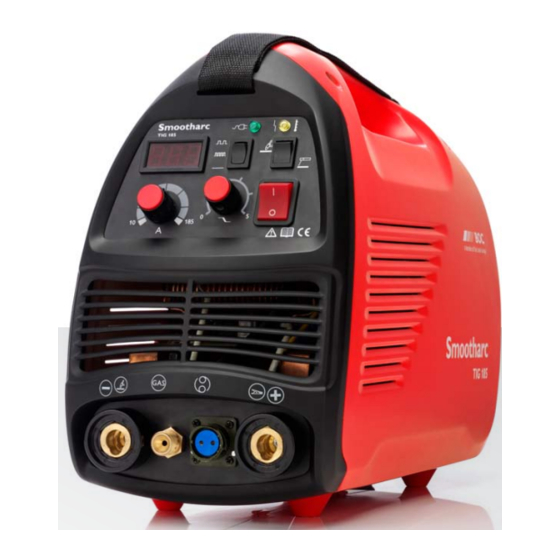BOC Smootharc TIG 185 DC 운영 매뉴얼 - 페이지 3
{카테고리_이름} BOC Smootharc TIG 185 DC에 대한 운영 매뉴얼을 온라인으로 검색하거나 PDF를 다운로드하세요. BOC Smootharc TIG 185 DC 15 페이지. Boc smootharc tig 185 dc welder
BOC Smootharc TIG 185 DC에 대해서도 마찬가지입니다: 서비스 매뉴얼 (19 페이지)

4
BOC Smootharc TIG 185 Operating Manual
1.0 Recommended Safety Precautions
1.1 Health hazard information
The actual process of welding is one that can
cause a variety of hazards. All appropriate safety
equipment should be worn at all times, i.e.
headwear, respiratory, hand and body protection.
Electrical equipment should be used in accordance
with the manufacturer's recommendations.
Eyes
The process produces ultra violet rays that can
injure and cause permanent damage. Fumes can
cause irritation.
Skin
Arc rays are dangerous to uncovered skin.
Inhalation
Welding fumes and gases are dangerous to the
health of the operator and to those in close
proximity. The aggravation of pre-existing
respiratory or allergic conditions may occur in some
workers. Excessive exposure may cause conditions
such as nausea, dizziness, dryness and irritation of
eyes, nose and throat.
1.2 Personal protection
Respiratory
Confined space welding should be carried out with
the aid of a fume respirator or air supplied respirator
as per AS/NZS 1715 and AS/NZS 1716 Standards.
•
You must always have enough ventilation in
confined spaces. Be alert to this at all times
•
Keep your head out of the fumes rising from the arc
•
Fumes from the welding of some metals could have
an adverse effect on your health. Don't breathe
them in. If you are welding on material such as
stainless steel, nickel, nickel alloys or galvanised
steel, further precautions are necessary
•
Wear a respirator when natural or forced
ventilation is not good enough
Eye protection
A welding helmet with the appropriate welding
filter lens for the operation must be worn at all
times in the work environment. The welding arc
and the reflecting arc flash gives out ultraviolet
and infrared rays. Protective welding screen and
goggles should be provided for others working in
the same area.
Clothing
Suitable clothing must be worn to prevent
excessive exposure to UV radiation and sparks. An
adjustable helmet, flameproof loose fitting cotton
clothing buttoned to the neck, protective leather
gloves, spats, apron and steel capped safety boots
are highly recommended.
Recommended filter shades for arc welding
Less than 150 amps
Shade 10*
150 to 250 amps
Shade 11*
250 to 300 amps
Shade 12
300 to 350 amps
Shade 13
Over 350 amps
Shade 14
*Use one shade darker for aluminium.
Cylinder safety diagram
1
Cylinder valve hand-wheel
2
Back-plug
3
Bursting disc
1
2
3
Back view of typical cylinder valve.
Operator wearing personal
protective equipment (PPE)
in safe position.
Ten points about cylinder safety
1
Read labels and Material Safety Data Sheet
(MSDS) before use
2
Store upright and use in well ventilated,
secure areas away from pedestrian or
vehicle thoroughfare
3
Guard cylinders against being knocked
violently or being allowed to fall
4
Wear safety shoes, glasses and gloves
when handling and connecting cylinders
5
Always move cylinders securely with an
appropriate trolley. Take care not to turn
the valve on when moving a cylinder
6
Keep in a cool, well ventilated area, away
from heat sources, sources of ignition
and combustible materials, especially
flammable gases
7
Keep full and empty cylinders separate
8
Keep ammonia-based leak detection
solutions, oil and grease away from
cylinders and valves
9
Never use force when opening or closing
valves
10
Don't repaint or disguise markings and
damage. If damaged, return cylinders to
BOC immediately
Cylinder valve safety
When working with cylinders or operating cylinder
valves, ensure that you wear appropriate protective
clothing – gloves, boots and safety glasses.
When moving cylinders, ensure that the valve is
not accidentally opened in transit.
BOC Smootharc TIG 185 Operating Manual
Before operating a cylinder valve
Ensure that the system you are connecting
the cylinder into is suitable for the gas and
pressure involved.
Ensure that any accessories (such as hoses
attached to the cylinder valve, or the system being
connected to) are securely connected. A hose, for
example, can potentially flail around dangerously if
it is accidentally pressurised when not restrained at
both ends.
Stand to the side of the cylinder so that neither
you nor anyone else is in line with the back of
the cylinder valve. This is in case a back-plug is
loose or a bursting disc vents. The correct stance is
shown in the diagram above.
When operating the cylinder valve
Open it by hand by turning the valve hand-wheel
anti-clockwise. Use only reasonable force.
Ensure that no gas is leaking from the cylinder
valve connection or the system to which the
cylinder is connected. DO NOT use ammonia-
based leak detection fluid as this can damage
the valve. Approved leak detection fluid, can be
obtained from a BOC Gas & Gear centre.
When finished with the cylinder, close the cylinder
valve by hand by turning the valve hand-wheel in a
clockwise direction. Use only reasonable force.
Remember NEVER tamper with the valve.
If you suspect the valve is damaged, DO NOT
use it. Report the issue to BOC and arrange for
the cylinder to be returned to BOC.
5
